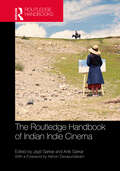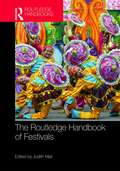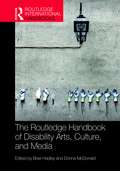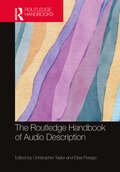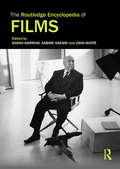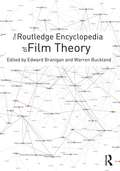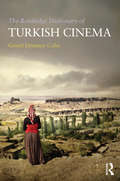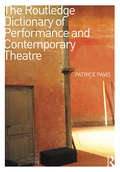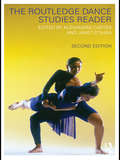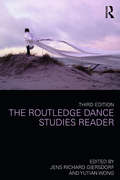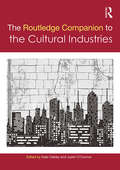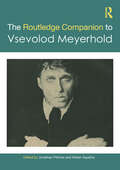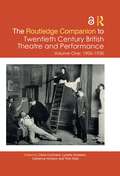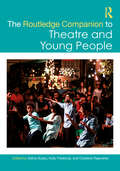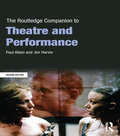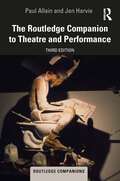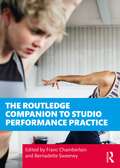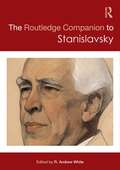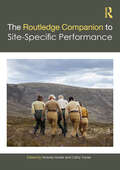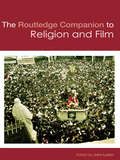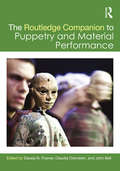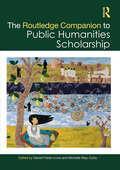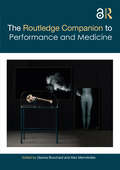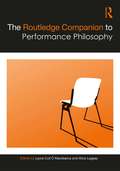- Table View
- List View
The Routledge Handbook of Indian Indie Cinema
by Anik Sarkar Jayjit SarkarThis handbook offers a critical introduction to Indian Indie cinema, exploring its subversion of dominant ideas, aesthetics and narratives; its inclusion of marginal and alternative experiences and ideologies; its relationship with audiences; and its defiance of norms followed by commercial Bollywood cinema.It takes a critical look at independent and alternative films in India that cover a wide range of genres, regions, textual forms and languages. These films may be regional, experimental in style or feature innovative and timely sociopolitical interventions. The handbook contextualises this cinema historically and addresses the key issues concerning its significance. A definitive guide to independent Indian films, this volume provides acritical understanding of the many experimentations undertaken by alternative voices and filmmakers in India; offers new conceptual engagements that widen perspectives on “minor” and regional cinema; and covers a wide range of films while touching upon current and new filmmaking trends, emerging cinematic styles, film production and key filmmakers.These analyses of the Indie film industry and films in India are an essential read for students and researchers of media and film studies, film studies, cultural studies, world cinema and contemporary cinema, besides being of interest to film buffs.
The Routledge Handbook of Festivals
by Judith MairIn recent times, festivals around the world have grown in number due to the increased recognition of their importance for tourism, branding and economic development. Festivals hold multifaceted roles in society and can be staged to bring positive economic impact, for the competitive advantage they lend a destination or to address social objectives. Studies on festivals have appeared in a wide range of disciplines, and consequently, much of the research available is highly fragmented. This handbook brings this knowledge together in one volume, offering a comprehensive evaluation of the most current research, debates and controversies surrounding festivals. It is divided into nine sections that cover a wide range of theories, concepts and contexts, such as sustainability, festival marketing and management, the strategic use of festivals and their future. Featuring a variety of disciplinary, cultural and national perspectives from an international team of authors, this book will be an invaluable resource for students and researchers of event management and will be of interest to scholars in the fields of anthropology, sociology, geography, marketing, management, psychology and economics.
The Routledge Handbook of Disability Arts, Culture, and Media
by Bree Hadley Donna McDonaldIn the last 30 years, a distinctive intersection between disability studies – including disability rights advocacy, disability rights activism, and disability law – and disability arts, culture, and media studies has developed. The two fields have worked in tandem to offer critique of representations of disability in dominant cultural systems, institutions, discourses, and architecture, and develop provocative new representations of what it means to be disabled. Divided into 5 sections: Disability, Identity, and Representation Inclusion, Wellbeing, and Whole-of-life Experience Access, Artistry, and Audiences Practices, Politics and the Public Sphere Activism, Adaptation, and Alternative Futures this handbook brings disability arts, disability culture, and disability media studies – traditionally treated separately in publications in the field to date – together for the first time. It provides scholars, graduate students, upper level undergraduate students, and others interested in the disability rights agenda with a broad-based, practical and accessible introduction to key debates in the field of disability art, culture, and media studies. An internationally recognised selection of authors from around the world come together to articulate the theories, issues, interests, and practices that have come to define the field. Most critically, this book includes commentaries that forecast the pressing present and future concerns for the field as scholars, advocates, activists, and artists work to make a more inclusive society a reality.
The Routledge Handbook of Audio Description (Routledge Handbooks in Translation and Interpreting Studies)
by Christopher Taylor Elisa PeregoThis Handbook provides a comprehensive overview of the expanding field of audio description, the practice of rendering the visual elements of a multimodal product such as a film, painting, or live performance in the spoken mode, for the benefit principally of the blind and visually impaired community. This volume brings together scholars, researchers, practitioners and service providers, such as broadcasters from all over the world, to cover as thoroughly as possible all the theoretical and practical aspects of this discipline. In 38 chapters, the expert authors chart how the discipline has become established both as an important professional service and as a valid academic subject, how it has evolved and how it has come to play such an important role in media accessibility. From the early history of the subject through to the challenges represented by ever-changing technology, the Handbook covers the approaches and methodologies adopted to analyse the “multimodal” text in the constant search for the optimum selection of the elements to describe. This is the essential guide and companion for advanced students, researchers and audio description professionals within the more general spheres of translation studies and media accessibility.
The Routledge Encyclopedia of Films
by John White Sarah Barrow Sabine HaenniThe Routledge Encyclopedia of Films comprises 200 essays by leading film scholars analysing the most important, influential, innovative and interesting films of all time. Arranged alphabetically, each entry explores why each film is significant for those who study film and explores the social, historical and political contexts in which the film was produced. Ranging from Hollywood classics to international bestsellers to lesser-known representations of national cinema, this collection is deliberately broad in scope crossing decades, boundaries and genres. The encyclopedia thus provides an introduction to the historical range and scope of cinema produced throughout the world.
The Routledge Encyclopedia of Film Theory
by Warren Buckland Edward BraniganThe Routledge Encyclopedia of Film Theory is an international reference work representing the essential ideas and concepts at the centre of film theory from the beginning of the twentieth century, to the beginning of the twenty-first. When first encountering film theory, students are often confronted with a dense, interlocking set of texts full of arcane terminology, inexact formulations, sliding definitions, and abstract generalities. The Routledge Encyclopedia of Film Theory challenges these first impressions by aiming to make film theory accessible and open to new readers. Edward Branigan and Warren Buckland have commissioned over 50 scholars from around the globe to address the difficult formulations and propositions in each theory by reducing these difficult formulations to straightforward propositions. The result is a highly accessible volume that clearly defines, and analyzes step by step, many of the fundamental concepts in film theory, ranging from familiar concepts such as ‘Apparatus’, ‘Gaze’, ‘Genre’, and ‘Identification’, to less well-known and understood, but equally important concepts, such as Alain Badiou’s ‘Inaesthetics’, Gilles Deleuze’s ‘Time-Image’, and Jean-Luc Nancy’s ‘Evidence’. The Routledge Encyclopedia of Film Theory is an ideal reference book for undergraduates of film studies, as well as graduate students new to the discipline.
The Routledge Dictionary of Turkish Cinema
by Gonul Donmez-ColinThe first critical and analytical dictionary of Turkish Cinema, this book provides a comprehensive overview of Turkish cinema from its beginnings to the present day. Addressing the lacuna in scholarly work on the topic, this dictionary provides immense detail on a wide range of aspects of Turkish cinema including; prominent filmmakers, films, actors, screenwriters, cinematographers, editors, producers, significant themes, genres, movements, theories, production modes, film journals, film schools and professional organizations. Extensively researched, elaborately detailed and written in a remarkably readable style, the Routledge Dictionary of Turkish Cinema will be invaluable for film scholars and researchers as a reference book and as a guide to the dynamics of the cinema of Turkey.
The Routledge Dictionary of Performance and Contemporary Theatre
by Patrice PavisThe Routledge Dictionary of Contemporary Theatre and Performance provides the first authoritative alphabetical guide to the theatre and performance of the last 30 years. Conceived and written by one of the foremost scholars and critics of theatre in the world, it literally takes us from Activism to Zapping, analysing everything along the way from Body Art and the Flashmob to Multimedia and the Postdramatic. What we think of as 'performance' and 'drama' has undergone a transformation in recent decades. Similarly how these terms are defined, used and critiqued has also changed, thanks to interventions from a panoply of theorists from Derrida to Ranciere. Patrice Pavis's Dictionary provides an indispensible roadmap for this complex and fascinating terrain; a volume no theatre bookshelf can afford to be without.
The Routledge Dance Studies Reader
by Janet O'Shea Alexandra CarterThe second edition of The Routledge Dance Studies Reader offers fresh critical perspectives on classic and modern dance forms, including ballroom, tango, Hip-hop, site-specific performance, and disability in dance. Alexandra Carter and Janet O'Shea deliver a substantially revised and updated collection of key texts, featuring an enlightening new introduction, which tracks differing approaches to dance studies. Important articles from the first edition are accompanied by twenty new works by leading critical voices. The articles are presented in five thematic sections, each with a new editorial introduction and further reading. Sections cover: Making dance Performing dance Ways of looking Locating dance in history and society Debating the discipline The Routledge Dance Studies Reader gives readers access to over thirty essential texts on dance and provides expert guidance on their critical context. It is a vital resource for anyone interested in understanding dance from a global and contemporary perspective.
The Routledge Dance Studies Reader
by Yutian Wong Jens Richard GiersdorfThe Routledge Dance Studies Reader has been expanded and updated, giving readers access to thirty-seven essential texts that address the social, political, cultural, and economic impact of globalization on embodiment and choreography. These interdisciplinary essays in dance scholarship consider a broad range of dance forms in relation to historical, ethnographic, and interdisciplinary research methods including cultural studies, reconstruction, media studies, and popular culture. This new third edition expands both its geographic and cultural focus to include recent research on dance from Southeast Asia, the People’s Republic of China, indigenous dance, and new sections on market forces and mediatization. Sections cover: Methods and approaches Practice and performance Dance as embodied ideology Dance on the market and in the media Formations of the field. The Routledge Dance Studies Reader includes essays on concert dance (ballet, modern and postmodern dance, tap, kathak, and classical khmer dance), popular dance (salsa and hip-hop), site-specific performance, digital choreography, and lecture-performances. It is a vital resource for anyone interested in understanding dance from a global and contemporary perspective.
The Routledge Companion to the Cultural Industries (Routledge Media and Cultural Studies Companions)
by Kate Oakley Justin O'ConnorThe Routledge Companion to the Cultural Industries is collection of contemporary scholarship on the cultural industries and seeks to re-assert the importance of cultural production and consumption against the purely economic imperatives of the ‘creative industries’. Across 43 chapters drawn from a wide range of geographic and disciplinary perspectives, this comprehensive volume offers a critical and empirically-informed examination of the contemporary cultural industries. A range of cultural industries are explored, from videogames to art galleries, all the time focussing on the culture that is being produced and its wider symbolic and socio-cultural meaning. Individual chapters consider their industrial structure, the policy that governs them, their geography, the labour that produces them, and the meaning they offer to consumers and participants. The collection also explores the historical dimension of cultural industry debates providing context for new readers, as well as critical orientation for those more familiar with the subject. Questions of industry structure, labour, place, international development, consumption and regulation are all explored in terms of their historical trajectory and potential future direction. By assessing the current challenges facing the cultural industries this collection of contemporary scholarship provides students and researchers with an essential guide to key ideas, issues, concepts and debates in the field.
The Routledge Companion to Vsevolod Meyerhold (Routledge Companions)
by Jonathan Pitches Stefan AquilinaThe Routledge Companion to Vsevolod Meyerhold brings together a wealth of scholarship on one of the foremost innovators in European theatre. It presents a detailed picture of the Russian director’s work from when it first emerged on the modern stage to its multifarious present-day manifestations. By combining an historical focus with the latest contemporary research from an international range of perspectives and authors, this collection marks an important moment in Meyerhold studies as well as offering a new assessment of his relation to today's theatre-making. Its dynamic blend of research is presented in five sections: Histories enlarges on more conventional subjects like the grotesque and Biomechanics, to overlooked topics such as Meyerhold's ‘failed’ projects and his work in film; Collaborations and Connections extends understandings of Meyerhold’s well-known collaborative capacities to consider new cultural influences and lesser known working relationships; Sources engages with hitherto untapped material in Meyerhold’s oeuvre by reproducing and contextualising previously untranslated primary sources on his work; Practitioner Voices offer lively, on the ground, testimony of the contemporary impact of Meyerhold's practice; Meyerhold in New Contexts maps the routes of his practice across continents and examines ways in which his work is being applied in a number of contemporary scenarios, such as motion capture, computer-based 3D visualisations, and the ‘new normal’ of digital pedagogy. This is a key resource for students and scholars of European Theatre, acting theory, and actor training, as well as for those more broadly interested in the socio-political impact of theatre.
The Routledge Companion to Twentieth Century British Theatre and Performance: Volume One: 1900–1950 (Routledge Companions)
by Lynette Goddard Trish Reid Claire Cochrane Catherine HindsonThe Routledge Companion to Twentieth Century British Theatre and Performance provides a broad range of perspectives on the multiple models and examples of theatre, artists, enthusiasts, enablers, and audiences that emerged over this formative 100-year period.This first volume covers the first half of the century, constructing an equitable and inclusive history that is more representative of the nation's lived experience than the traditional narratives of British theatre. Its approach is intra-national – weaving together the theatres and communities of England, Scotland, Wales, and Northern Ireland. The essays are organised thematically arranged into sections that address nation, power, and identity; fixity and mobility; bodies in performance; the materiality of theatre and communities of theatre. This approach highlights the synergies, convergences, and divergences of the theatre landscape in Britain during this period, giving a sense of the sheer variety of performance that was taking place at any given moment in time.This is a fascinating and indispensable resource for undergraduate and graduate students, postgraduate researchers, and scholars across theatre and performance studies, cultural studies, and twentieth-century history.
The Routledge Companion to Theatre and Young People (Routledge Companions)
by Kelly Freebody Charlene Rajendran Selina BusbyThis companion interrogates the relationship between theatre and youth from a global perspective, taking in performances and theatre made by, for, and about young people. These different but interrelated forms of theatre are addressed through four critical themes that underpin the ways in which analysis of contemporary theatre in relation to young people can be framed: political utterances – exploring the varied ways theatre becomes a platform for political utterance as a process of dialogic thinking and critical imagining; critical positioning – examining youth theatre work that navigates the sensitive, dynamic, and complex terrains in which young people live and perform; pedagogic frames – outlining a range of contexts and programmes in which young people learn to make and understand theatre that reflects their artistic capacities and aesthetic strategies; applying performance – discussing a range of projects and companies whose work has been influential in the development of youth theatre within specific contexts. Providing critical, research-informed, and research-based discussions on the intersection between young people, their representation, and their participation in theatre, this is a landmark text for students, scholars, and practitioners whose work and thinking involves theatre and young people.
The Routledge Companion to Theatre and Performance (Routledge Companions)
by Paul Allain Jen HarvieWhat is theatre? What is performance? What connects them and how are they different? What events, people, practices and ideas have shaped theatre and performance in the twentieth and twenty-first century? The Routledge Companion to Theatre and Performance offers some answers to these big questions. It provides an analytical, informative and engaging introduction to important people, companies, events, concepts and practices that have defined the complementary fields of theatre and performance studies. This fully updated second edition contains three easy to use alphabetized sections including over 120 revised entries on topics and people ranging from performance artist Ron Athey, to directors Vsevold Meyerhold and Robert Wilson, megamusicals , postdramatic theatre and documentation. Each entry includes crucial historical and contextual information, extensive cross-referencing, detailed analysis and an annotated bibliography. The Routledge Companion to Theatre and Performance is a perfect reference guide for the keen student.
The Routledge Companion to Theatre and Performance (Routledge Companions)
by Paul Allain Jen HarvieWhat is theatre? What is performance? What connects them and how are they different? How have they been shaped by events, people, companies, practices and ideas in the twentieth and twenty-first centuries? And where are they heading next? The Routledge Companion to Theatre and Performance offers some answers to these big questions. This third edition has been updated to now include over 160 entries, with all entries brought up to date and new topics added, including Caryl Churchill, Black Lives Matter and Hamilton, among others.This book provides an accessible, informative and engaging introduction to important people and companies, events, concepts and practices that have defined the complementary fields of theatre and performance studies. Three easy-to-use alphabetized sections include entries on topics and people ranging from performance artists Marina Abramović and Pope.L to directors Vsevolod Meyerhold and Robert Wilson, the haka, Taking the Knee and disability, theatre and performance. Each entry includes important historical and contextual information, extensive cross-referencing, detailed analysis and an annotated bibliography.The Routledge Companion to Theatre and Performance is a perfect reference guide for the keen student and the passionate theatre-goer alike.
The Routledge Companion to Studio Performance Practice
by Franc ChamberlainThe Routledge Companion to Studio Performance Practice is a unique, indispensable guide to the training methods of the world’s key theatre practitioners. Compiling the practical work outlined in the popular Routledge Performance Practitioners series of guidebooks, each set of exercises has been edited and contextualised by an expert in that particular approach. Each chapter provides a taster of one practitioner’s work, answering the same key questions: ‘How did this artist work? How can I begin to put my understanding of this to practical use?’ Newly written chapter introductions put the exercises in context, explaining how they fit into the wider methods and philosophy of the practitioner in question. All 21 volumes in the original series are represented in this volume.
The Routledge Companion to Stanislavsky (Routledge Companions Ser.)
by R. Andrew WhiteStanislavsky’s system of actor-training has revolutionised modern theatre practice, and he is widely recognised to be one of the great cultural innovators of the twentieth century. The Routledge Companion to Stanislavsky is an essential book for students and scholars alike, providing the first overview of the field for the 21st century. An important feature of this book is the balance between Stanislavsky’s theory and practice, as international contributors present scholarly and artistic interpretations of his work. With chapters including academic essays and personal narratives, the Companion is divided into four clear parts, exploring Stanislavsky on stage, as an acting teacher, as a theorist and finally as a theatre practitioner. Bringing together a dazzling selection of original scholarship, notable contributions include:Anatoly Smeliansky on Stanislavsky’s lettersWilliam D. Gunn on staging ideology at the Moscow Art TheatreSharon Marie Carnicke and David Rosen on opera Rosemary Malague on the feminist perspective of new translationsW.B. Worthen on cognitive scienceJulia Listengarten on the avant-gardeDavid Krasner on the System in America and Dennis Beck on Stanislavsky’s legacy in non-realistic theatre R. Andrew White is Associate Professor of Theatre at Valparaiso University, where he annually directs productions. He has an MFA in Acting from Carnegie Mellon University and the Moscow Art Theatre School, and has worked as an actor at a variety of theatres in the United States. In addition, his scholarship has appeared in edited works published by Routledge and Palgrave Macmillan, as well as in top American journals including Theatre Survey, TDR/The Drama Review, and New England Theatre Journal.
The Routledge Companion to Site-Specific Performance (Routledge Companions)
by Victoria Hunter Cathy TurnerThis collection comprises a comprehensive overview of key themes, arguments, and practices central to the study and understanding of site-specific performance.Its collected essays, case studies, and practitioner accounts represent a must-have resource that engages with established and emergent ideas, themes, and practices central to this performance sub-discipline. Acknowledging the interdisciplinary nature of this field emergent through the creation and presentation of performance in non-theatre spaces, the companion includes writing from scholars whose work intersects with ideas from a range of related fields including dance, theatre, dramaturgy, human geography, architecture, walking studies, and archaeology. Alongside theoretical discussions and case study examples, a section on methods and structures allows site-specific practitioners to illustrate a range of practical approaches, tasks, and modes of producing site-specific performance in a range of sites.This interdisciplinary survey brings together practices and voices from a wide range of global contexts, demonstrating and challenging the breadth of site-specific discourse. It provides a rich palette of perspectives, approaches, and ideas for students, academics, and researchers to draw from.
The Routledge Companion to Religion and Film (Routledge Religion Companions)
by John LydenThe Routledge Companion to Religion and Film brings together a lively and experienced team of contributors to introduce students to the key topics in religion and film and to investigate the ways in which the exciting subject of religion and film is developing for more experienced scholars. Divided into four parts, the Companion: analyzes the history of the interaction of religion and film, through periods of censorship as well as appreciation of the medium studies religion-in-film, examining how the world’s major religions, as well as Postcolonial, Japanese and New Religions, are depicted by and within films uses diverse methodologies to explore religion and film, such as psychoanalytical, theological and feminist approaches, and audience reception analyzes religious themes in film, including Redemption, the Demonic, Jesus or Christ Figures, Heroes and Superheroes considers films as diverse as The Passion of the Christ, The Matrix, Star Wars and Groundhog Day. This definitive book provides an accessible resource to this emerging field and is an indispensable guide to religion and film for students of Religion, Film Studies, and beyond.
The Routledge Companion to Puppetry and Material Performance (Routledge Companions)
by John Bell Claudia Orenstein Dassia N. PosnerThe Routledge Companion to Puppetry and Material Performance offers a wide-ranging perspective on how scholars and artists are currently re-evaluating the theoretical, historical, and theatrical significance of performance that embraces the agency of inanimate objects. This book proposes a collaborative, responsive model for broader artistic engagement in and with the material world. Its 28 chapters aim to advance the study of the puppet not only as a theatrical object but also as a vibrant artistic and scholarly discipline. This Companion looks at puppetry and material performance from six perspectives: theoretical approaches to the puppet, perspectives from practitioners, revisiting history, negotiating tradition, material performances in contemporary theatre, and hybrid forms. Its wide range of topics, which span 15 countries over five continents, encompasses: • visual dramaturgy • theatrical juxtapositions of robots and humans • contemporary transformations of Indonesian wayang kulit • Japanese ritual body substitutes • recent European productions featuring toys, clay, and food. The book features newly commissioned essays by leading scholars such as Matthew Isaac Cohen, Kathy Foley, Jane Marie Law, Eleanor Margolies, Cody Poulton, and Jane Taylor. It also celebrates the vital link between puppetry as a discipline and as a creative practice with chapters by active practitioners, including Handspring Puppet Company’s Basil Jones, Redmoon’s Jim Lasko, and Bread and Puppet’s Peter Schumann. Fully illustrated with more than 60 images, this volume comprises the most expansive English-language collection of international puppetry scholarship to date.
The Routledge Companion to Public Humanities Scholarship (Routledge Literature Companions)
by Daniel Fisher-Livne Michelle May-CurryAcross humanities disciplines, public scholarship brings academics and community members and organizations together in mutually-beneficial partnership for research, teaching, and programming. While the field of publicly engaged humanities scholarship has been growing for some time, there are few volumes that have attempted to define and represent its scope. The Routledge Companion to Public Humanities Scholarship brings together wide-ranging case studies sharing perspectives on this work, grounded in its practice in the United States.The collection begins with chapters reflecting on theories and practices of public humanities scholarship. The case studies that follow are organized around six areas of particular impact in public humanities scholarship: Informing contemporary debates; amplifying community voices and histories; helping individuals and communities navigate difficult experiences; preserving culture in times of crisis and change; expanding educational access; and building and supporting public scholarship. The Companion concludes with a glossary, introducing select concepts. Taken together, these resources offer an overview for students and practitioners of public humanities scholarship, creating an accessible vocabulary rooted in the practices that have so advanced academic and community life.Although drawing on case studies from the US, these examples offer perspectives and insights relevant to public humanities around the world. This book will be of interest to anyone working within the public humanities or wanting to make their work public and engage with wider communities.
The Routledge Companion to Performance-Related Concepts in Non-European Languages (ISSN)
by Erika Fischer-Lichte Torsten Jost Astrid SchenkaInvestigating more than 70 key concepts relating to the performing arts in more than six non-European languages, this volume provides a groundbreaking research tool and one-of-a-kind reference source for theatre, performance and dance studies worldwide.The Companion features in-depth explorations of and expert introductions to a select number of performance-related key concepts in Arabic, Chinese, Japanese, Korean, Yorùbá as well as the Indian languages Sanskrit, Hindi and Tamil. Key concepts—such as Furǧa فرجة in Arabic, for example, or Jiadingxing 假定性 in Chinese, Gei 芸 in Japanese, Ìparadà in Yorùbá and Imyeon 이면 in Korean—that defy easy translation from one language to another (and especially into English as the world’s lingua franca) and that reflect culturally specific ways of thinking and talking about the performing arts are thoroughly examined in in-depth articles. Written by more than 60 distinguished scholars from around the globe, the articles describe in detail each concept’s dynamic history, its flexible scope of meaning and current range of usage. The Companion also includes extensive introductions to each language section, in which internationally renowned experts explain how the presented key concepts are situated within, and are constitutive of, distinct and dynamic epistemic systems that have different yet always interlinked histories and orientations. Offers a fascinating insight into the unique histories, characteristics, and orientations of linguistically and culturally distinct epistemic systems related to the performative arts Contains extensive cross-references and bibliographies An invaluable research tool and one-of-a-kind reference source for scholars and students worldwide and across the humanities, especially in the fields of theatre, performance, dance, translation, area and cultural studies An accessible handbook for everybody interested in performance cultures and performance-related knowledge systems existing in the world today. This volume provides an invaluable research tool and one-of-a-kind reference source for scholars and students worldwide and across the humanities, especially in the fields of theatre, performance, dance, translation and area studies, history (of science and the humanities) and cultural studies.
The Routledge Companion to Performance and Medicine (Routledge Companions)
by Alex Mermikides Gianna BouchardThe Routledge Companion to Performance and Medicine addresses the proliferation of practices that bridge performance and medicine in the contemporary moment.The scope of this book's broad range of chapters includes medicine and illness as the subject of drama and plays; the performativity of illness and the medical encounter; the roles and choreographies of the clinic; the use of theatrical techniques, such as simulation and role-play, in medical training; and modes of performance engaged in public health campaigns, health education projects and health-related activism. The book encompasses some of these diverse practices and discourses that emerge at the interface between medicine and performance, with a particular emphasis on practices of performance.This collection is a vital reference resource for scholars of contemporary performance; medical humanities; and the variety of interdisciplinary fields and debates around performance, medicine, health and their overlapping collaborations.Chapter 18 of this book is freely available as a downloadable Open Access PDF at http://www.taylorfrancis.com under a Creative Commons Attribution CC-BY 4.0 license.
The Routledge Companion to Performance Philosophy (Routledge Companions)
by Laura Cull Ó MaoilearcaThe Routledge Companion to Performance Philosophy is a volume of especially commissioned critical essays, conversations, collaborative, creative and performative writing mapping the key contexts, debates, methods, discourses and practices in this developing field. Firstly, the collection offers new insights on the fundamental question of how thinking happens: where, when, how and by whom philosophy is performed. Secondly, it provides a plurality of new accounts of performance and performativity – as the production of ideas, bodies and knowledges – in the arts and beyond. Comprising texts written by international artists, philosophers and scholars from multiple disciplines, the essays engage with questions of how performance thinks and how thought is performed in a wide range of philosophies and performances, from the ancient to the contemporary. Concepts and practices from diverse geographical regions and cultural traditions are analysed to draw conclusions about how performance operates across art, philosophy and everyday life. The collection both contributes to and critiques the philosophy of music, dance, theatre and performance, exploring the idea of a philosophy from the arts. It is crucial reading material for those interested in the hierarchy of the relationship between philosophy and the arts, advancing debates on philosophical method, and the relation between Performance and Philosophy more broadly.
